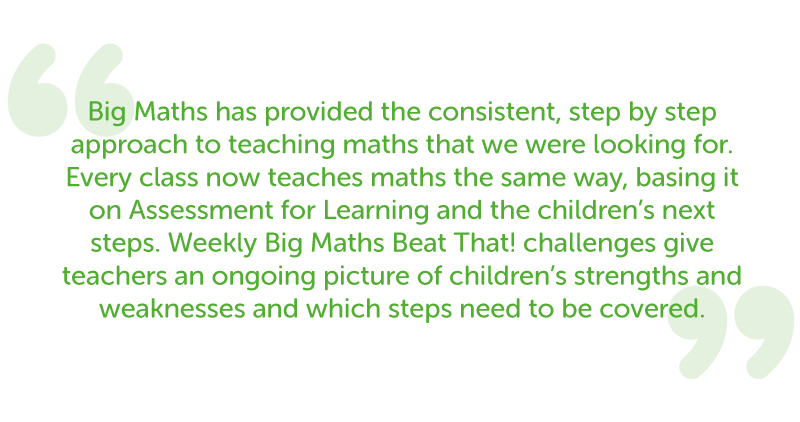Maths Mastery Curriculum
In 2010 Big Maths introduced the idea that the bulk of a cohort (any child without a genuine learning difficulty for maths, or what looks like a genuine gift for maths) should be brought to the same point in the numeracy learning journey. This ‘pre-managed spread’ allows the teacher to guide them forward together, as one large group. In 2014 the English government ‘introduced’ this idea as an Asian approach called ‘mastery’, elements of which have since made their way into Wales and Scotland. Most schemes and approaches that existed before the word ‘mastery’ agenda took hold were adapted to tick the boxes of the education authorities. Big Maths wasn’t changed, therefore appearing to some that it wasn’t a mastery curriculum, yet, in reality, it is the original UK maths mastery curriculum!

The principles of Big Maths prioritise the following features:
- A curriculum that recognises a Basic Skills journey and a Wider Maths journey to provide clear progression and expectations. Children’s progress on their Basic Skills journey should always inform (and be prioritised over) the Wider Maths skills that they can be introduced to.
- We believe that all children can attain the expected journey being outlined. Indeed, with any curriculum this shouldn’t just be a ‘belief’, but rather the rationale that should be evidenced in the curriculum design. In Big Maths you can always see why all children can attain the progression in fluency being described.
- For this to work, then the early stages of the journey must be light and ‘doable’ for all. Big Maths advocates a relatively low age-related expectation in the early years. This allows children who start school with relatively low attainment to be quickly brought into the expected journey for fluency with number. This is achieved by having a strong focus (i.e. intensity and consistency) on the teacher-modelling and the child copying, with explicit instruction of doing and understanding from expert to novice. We advocate the ‘I do’, ‘We do’, ‘You do’ model of teaching.
- Again, for all this to work, then children who have mastered the expectations of fluency ahead of the rest of their cohort (or ahead of the fluency journey expectations) are stretched with their mathematical thinking into other areas of the maths curriculum (for example, problem-solving, maths investigations and connecting their number fluency to shapes, fractions, etc.). These children do not simply press on with the fluency journey.
- However, there may be a small group of genuinely elite mathematicians (and it may well look as if they are gifted) who are ahead of the expected fluency journey. This small group provides a management challenge to the teacher (as do those with a genuine special need) and may well need different input to the main group.
- The outcome of the successful implementation of this curriculum is that the teacher can give input on fluency journey progression to one large group. A common error of a mastery curriculum implementation is that the teacher gives input to one large group where there is a spread of number ability. The teacher then attempts to differentiate through group work after the main input. A successful mastery curriculum provides the teacher with a ‘pre-managed spread’ (due to the reasons described above), not an unmanaged spread. In a well-implemented mastery curriculum, the teacher should have a reduction in workload in this regard (preparing fewer inputs and managing less group work).

